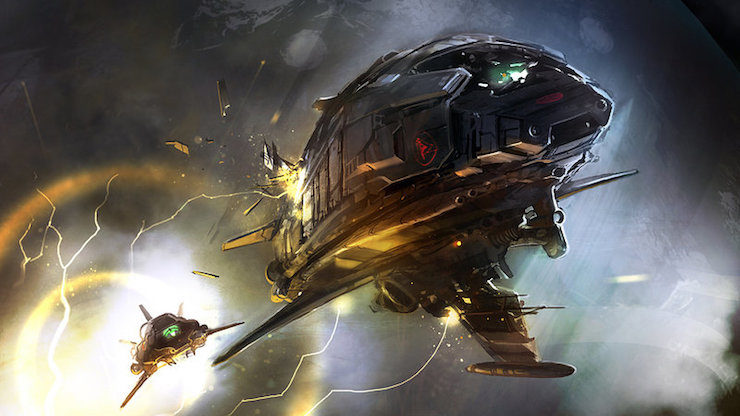Space operas are fun—they vary greatly in theme and content, but all share a focus on the adventure and sense of wonder that brought so many of us to science fiction in the first place. Most science fiction readers, when asked to pick favorites, could name dozens of space opera universes, and ranking them subjectively is often like choosing between apples and oranges. So, I’m going to need help from the readers to ensure they all get their due. I’ll start off mentioning ten of my favorites, and then open the floor to you.
During the Golden Age of Science Fiction, there was a lot of concern about the amount of apparent dross being mixed in with the gold. The term “space opera” was originally coined to describe some of the more formulaic stories, a term used in the same derisive manner as “soap opera” or “horse opera.” But, like many other negative terms over the years, the term space opera has gradually taken on more positive qualities. Now, it is used to describe stories that deal with huge cosmic mysteries, grand adventure, the long sweep of history, and giant battles. If stories have a large scope and a boundless sense of wonder, along with setting adventure front and center, they now proudly wear the space opera name. One of the aspects that puts a story or stories in the space opera category is the universe where they are set. These tales often sprawl across the centuries, throughout the galaxy, between star-spanning civilizations, and involve a diversity of alien species. At the same time, they often sprawl across a whole series of books or stories.
In no particular order, here are some of my personal favorite space opera universes, and some of the reasons why I enjoyed them…
Uplift Universe (David Brin)
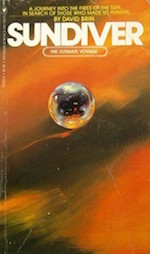 One indicator of a good space opera is that it gives readers the chance to encounter strange new beings. In the Uplift Universe, the human race has experimented with dolphins and simians, uplifting them toward sapience; and then humanity finds the stars filled with alien races, races who have uplifted each other. Each new race benefits from their patrons, who protect them as they develop…but the seemingly orphaned humans have no patrons, which causes them to be greeted with suspicion. Two books in this series stand out from the others: Startide Rising follows the crew of the starship Streaker, a mix of dolphins, humans, and one chimpanzee, who find an ancient derelict fleet of starships and end up stranded on a distant world, fighting for survival. The Uplift War takes place on a planet colonized by humans and neo-chimps, invaded and held hostage by the alien Gubru in order to force the humans to reveal what the Streaker discovered. The central concept of uplift is intriguing, and this big universe is filled with strange aliens and wonder. This series is extremely popular, and many fans would like Brin return to this setting; in the last several years, the author himself has mentioned possible plans for at least one more book in the Uplift Universe.
One indicator of a good space opera is that it gives readers the chance to encounter strange new beings. In the Uplift Universe, the human race has experimented with dolphins and simians, uplifting them toward sapience; and then humanity finds the stars filled with alien races, races who have uplifted each other. Each new race benefits from their patrons, who protect them as they develop…but the seemingly orphaned humans have no patrons, which causes them to be greeted with suspicion. Two books in this series stand out from the others: Startide Rising follows the crew of the starship Streaker, a mix of dolphins, humans, and one chimpanzee, who find an ancient derelict fleet of starships and end up stranded on a distant world, fighting for survival. The Uplift War takes place on a planet colonized by humans and neo-chimps, invaded and held hostage by the alien Gubru in order to force the humans to reveal what the Streaker discovered. The central concept of uplift is intriguing, and this big universe is filled with strange aliens and wonder. This series is extremely popular, and many fans would like Brin return to this setting; in the last several years, the author himself has mentioned possible plans for at least one more book in the Uplift Universe.
Technic History (Poul Anderson)
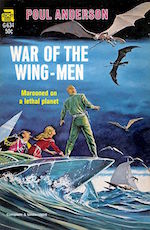 The grand sweep of history and massive star-spanning empires are key aspects of space operas. Chronicling the rise and fall of civilizations gives writers a large canvas to paint their stories upon: settings rich in drama and adventure, where larger-than-life characters can strive and struggle. Anderson’s Technic History follows humanity’s expansion into the stars and their struggles to maintain the civilization they have constructed. The earlier stories deal largely with the Polesotechnic League, a trading union that is the engine driving human expansion. The bombastic and colorful trader Nicholas van Rijn, head of the Solar Spice and Liquors Company, is at center stage for many of these tales. His protégé, the more cautious David Falkayn, continues van Rijn’s trading efforts as he becomes his own man. And, as capitalism and democracy give way to a decadent Terran Empire, the flamboyant and self-assured intelligence agent Captain Dominic Flandry struggles to hold back the “Long Night” that will inevitably follow the fall of the empire. Anderson’s characters are not always likeable, but they are always interesting, and their adventures never fail to entertain.
The grand sweep of history and massive star-spanning empires are key aspects of space operas. Chronicling the rise and fall of civilizations gives writers a large canvas to paint their stories upon: settings rich in drama and adventure, where larger-than-life characters can strive and struggle. Anderson’s Technic History follows humanity’s expansion into the stars and their struggles to maintain the civilization they have constructed. The earlier stories deal largely with the Polesotechnic League, a trading union that is the engine driving human expansion. The bombastic and colorful trader Nicholas van Rijn, head of the Solar Spice and Liquors Company, is at center stage for many of these tales. His protégé, the more cautious David Falkayn, continues van Rijn’s trading efforts as he becomes his own man. And, as capitalism and democracy give way to a decadent Terran Empire, the flamboyant and self-assured intelligence agent Captain Dominic Flandry struggles to hold back the “Long Night” that will inevitably follow the fall of the empire. Anderson’s characters are not always likeable, but they are always interesting, and their adventures never fail to entertain.
Robert Heinlein’s Juveniles
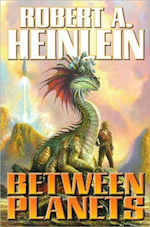 While Heinlein is best known for his Future History, he also wrote several “juveniles,” books that today would be classified for and marketed toward young adults. The stories are loosely connected, and follow humanity as it spreads through the solar system and into the stars. The stories often echo Heinlein’s theme of self-reliance in the face of the tendency of governments to decay into tyranny. Some feel dated, but all are still worth reading, and some stand out from the crowd. In Have Spacesuit—Will Travel, a young man repairs a spacesuit he won in a contest, not knowing this will be his ticket to achieve his dream of traveling into space. Tunnel in the Sky follows the adventures of a group of young people in a survival exercise who find themselves stranded, and the exercise becoming a real life and death struggle. Between Planets follows a young space-born man, without a country of his own, caught in a battle for independence between Earth and its colonies, in which the tyrants find it is not good to anger scientists.
While Heinlein is best known for his Future History, he also wrote several “juveniles,” books that today would be classified for and marketed toward young adults. The stories are loosely connected, and follow humanity as it spreads through the solar system and into the stars. The stories often echo Heinlein’s theme of self-reliance in the face of the tendency of governments to decay into tyranny. Some feel dated, but all are still worth reading, and some stand out from the crowd. In Have Spacesuit—Will Travel, a young man repairs a spacesuit he won in a contest, not knowing this will be his ticket to achieve his dream of traveling into space. Tunnel in the Sky follows the adventures of a group of young people in a survival exercise who find themselves stranded, and the exercise becoming a real life and death struggle. Between Planets follows a young space-born man, without a country of his own, caught in a battle for independence between Earth and its colonies, in which the tyrants find it is not good to anger scientists.
Galactic Center Saga (Gregory Benford)
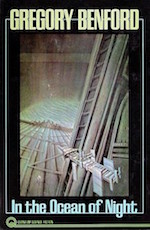 Adventure is sometimes defined as reading about someone else’s problems in the comfort of your own armchair. And the more desperate the situation for the protagonists, the greater the adventure. Benford’s Galactic Center Saga starts with In the Ocean of Night. In the near future, British astronaut Nigel Walmsley is sent to divert a comet that will strike Earth, and uncovers the existence of an alien mechanical civilization that spans the galaxy, which considers organic beings to be pests deserving extermination. The second book, Across the Sea of Suns, continues Walmsley’s story, as humans find remnants of a civilization in a nearby solar system destroyed by the machines, and Earth finds itself under attack from genetically engineered creatures. The third book, Great Sky River, jumps to the far future, where the Bishop family, heirs to the human race on the planet Snowglade, fight back against invading Mechs. Over the centuries, humanity has been engineered almost beyond recognition with cybernetic augmentation and mechanical implants. From there, the Saga continues over three more novels and a novella; the constant threats keep the reader gripped, and the pages turning.
Adventure is sometimes defined as reading about someone else’s problems in the comfort of your own armchair. And the more desperate the situation for the protagonists, the greater the adventure. Benford’s Galactic Center Saga starts with In the Ocean of Night. In the near future, British astronaut Nigel Walmsley is sent to divert a comet that will strike Earth, and uncovers the existence of an alien mechanical civilization that spans the galaxy, which considers organic beings to be pests deserving extermination. The second book, Across the Sea of Suns, continues Walmsley’s story, as humans find remnants of a civilization in a nearby solar system destroyed by the machines, and Earth finds itself under attack from genetically engineered creatures. The third book, Great Sky River, jumps to the far future, where the Bishop family, heirs to the human race on the planet Snowglade, fight back against invading Mechs. Over the centuries, humanity has been engineered almost beyond recognition with cybernetic augmentation and mechanical implants. From there, the Saga continues over three more novels and a novella; the constant threats keep the reader gripped, and the pages turning.
The Mote (Jerry Pournelle and Larry Niven)
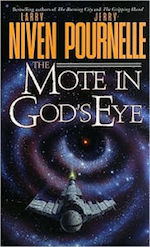 You don’t need to cross the entire galaxy in a space opera—some stories can pack their adventure into a very small corner of space. The star system of the Mote is one such setting. Either Niven or Pournelle could have made this list on his own: Niven for the tales set in his Known Space universe, and Pournelle for military SF adventures in his CoDominium/Empire of Man series. In the Mote stories, Pournelle’s militaristic Empire encounters an alien species in a system cut off from the rest of the universe, a species that ranks among the strangest Niven has ever created. The first book, The Mote in God’s Eye, is notable for its worldbuilding and tense narrative, while the second book, The Gripping Hand, has some of the best space battles ever written, and brings the tale to a satisfying conclusion. We see heroism, greed, redemption, politics, and all the other traits of humanity come into conflict with a race that has motivations, strengths and weaknesses that are unlike anything those humans have ever before encountered. The science is solid, the characters and societies feel real, and everything moves at a rollicking pace.
You don’t need to cross the entire galaxy in a space opera—some stories can pack their adventure into a very small corner of space. The star system of the Mote is one such setting. Either Niven or Pournelle could have made this list on his own: Niven for the tales set in his Known Space universe, and Pournelle for military SF adventures in his CoDominium/Empire of Man series. In the Mote stories, Pournelle’s militaristic Empire encounters an alien species in a system cut off from the rest of the universe, a species that ranks among the strangest Niven has ever created. The first book, The Mote in God’s Eye, is notable for its worldbuilding and tense narrative, while the second book, The Gripping Hand, has some of the best space battles ever written, and brings the tale to a satisfying conclusion. We see heroism, greed, redemption, politics, and all the other traits of humanity come into conflict with a race that has motivations, strengths and weaknesses that are unlike anything those humans have ever before encountered. The science is solid, the characters and societies feel real, and everything moves at a rollicking pace.
Liaden Universe (Sharon Lee and Steve Miller)
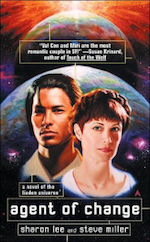 Space opera is often notable for its ability to bring romance and interpersonal relationships to the fore in compelling ways. In the far future setting of Agent of Change, a mercenary, Miri Robertson, encounters an intelligence agent and scout, Val Con yos’Phelium, who is fighting the effects of brainwashing, and in the course of dealing with their troubles, the two fall in love. There are three distinct human civilizations in this future: the formal and custom-bound Liaden, the less disciplined Terrans, and the warlike Yxtrang. There is also an intelligent race of giant turtles and at least one intelligent tree, and the many cats portrayed in the series are so clever they may as well be considered an intelligent race. Interstellar commerce is conducted by independent traders, with pilots highly prized members of an exclusive guild. Val Con is a member of the Liaden Clan Korval, and the series largely deals with the members of his extended family, with intrigue, action, and large dollops of romance. Counting short story collections, there are now more than twenty volumes in the series, with more in the pipeline.
Space opera is often notable for its ability to bring romance and interpersonal relationships to the fore in compelling ways. In the far future setting of Agent of Change, a mercenary, Miri Robertson, encounters an intelligence agent and scout, Val Con yos’Phelium, who is fighting the effects of brainwashing, and in the course of dealing with their troubles, the two fall in love. There are three distinct human civilizations in this future: the formal and custom-bound Liaden, the less disciplined Terrans, and the warlike Yxtrang. There is also an intelligent race of giant turtles and at least one intelligent tree, and the many cats portrayed in the series are so clever they may as well be considered an intelligent race. Interstellar commerce is conducted by independent traders, with pilots highly prized members of an exclusive guild. Val Con is a member of the Liaden Clan Korval, and the series largely deals with the members of his extended family, with intrigue, action, and large dollops of romance. Counting short story collections, there are now more than twenty volumes in the series, with more in the pipeline.
Babylon 5 (J. Michael Straczynski)
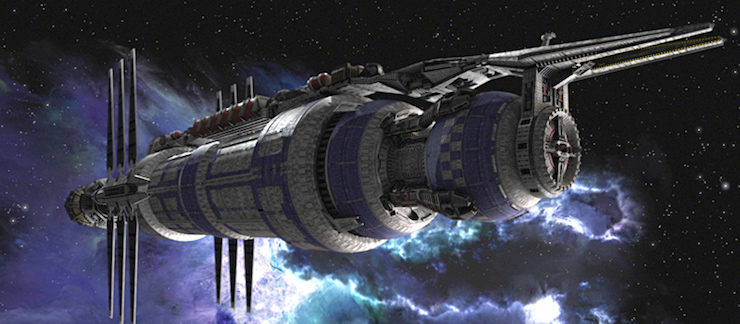
If you ignore media like TV and movies, you will miss some of the best space opera universes. The visual media is perfect for big, sprawling stories, and here, Straczynski has created an innovative and immersive setting for grand adventure. Babylon 5 is a space station established by humans, rather primitive newcomers, in order to open relations and trade with the many races that inhabit the galaxy. Alien races the humans interact with include the warlike Narn, the sybaritic Centauri, and the spiritual Minbari. The mysterious Vorlons support human efforts, but are opposed by the spider-like Shadows. The show was innovative in abandoning the traditional episodic structure after its first season, instead relying on a strong story arc that allowed the tale to build to an epic conclusion. The series also used computer graphics instead of models to portray its spaceships and other worlds; combined with careful set design and production scheduling, this allowed the show to function with a very modest budget. Babylon 5 also put a strong focus on its characters, and their development and growth over time. The result is one of the greatest science fiction epics to appear on television.
Zones of Thought (Vernor Vinge)
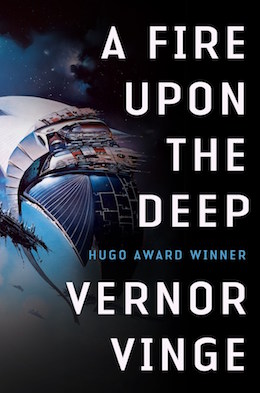 Some of the best space opera plays with the laws of nature to create an exciting universe. In the late 1980s, Vernor Vinge realized that technological advances threatened the space opera settings he enjoyed in his youth. His solution was to develop a concept partitioning the galaxy into the “Zones of Thought.” Earth is in the “Slow Zone,” where travel and communications are limited to lightspeed, and superhuman intelligence is impossible. At the galactic core, the “Unthinking Depths,” even human-level intelligence is impossible. In the galactic fringe, the “Beyond,” the speed of light is no longer a limiting factor, and superhuman intelligences thrive. The series includes four works; a novelette, “The Blabber,” and three novels: A Fire Upon the Deep, A Deepness in the Sky, and Children of the Sky. Alien races include the Tines, seal-like creatures who only become sentient when they work in packs, and the Skrodriders, sentient plants in symbiotic relationships with mechanical carts known as Skrods. Humans are constantly tempted by the magical technology of the Beyond, but along with that technology comes unimaginable threats as well. The stories are a joy, full of adventure and wonder, epic battles and exploration.
Some of the best space opera plays with the laws of nature to create an exciting universe. In the late 1980s, Vernor Vinge realized that technological advances threatened the space opera settings he enjoyed in his youth. His solution was to develop a concept partitioning the galaxy into the “Zones of Thought.” Earth is in the “Slow Zone,” where travel and communications are limited to lightspeed, and superhuman intelligence is impossible. At the galactic core, the “Unthinking Depths,” even human-level intelligence is impossible. In the galactic fringe, the “Beyond,” the speed of light is no longer a limiting factor, and superhuman intelligences thrive. The series includes four works; a novelette, “The Blabber,” and three novels: A Fire Upon the Deep, A Deepness in the Sky, and Children of the Sky. Alien races include the Tines, seal-like creatures who only become sentient when they work in packs, and the Skrodriders, sentient plants in symbiotic relationships with mechanical carts known as Skrods. Humans are constantly tempted by the magical technology of the Beyond, but along with that technology comes unimaginable threats as well. The stories are a joy, full of adventure and wonder, epic battles and exploration.
Spiral Arm Sequence (Michael Flynn)
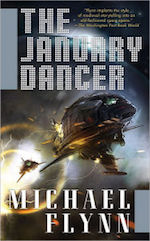 Sometimes, even hard science fiction writers feel the siren call of high adventure, and set their sights on the far future, and heady times of myth and legend. Once such author is Michael Flynn, who has written four books set in a time where ancient Terra is only a legend. The January Dancer is a tale told to a wandering harper involving an ancient alien MacGuffin and the tramp freighter crew that finds it. In Up Jim River, that harper, Mearana, takes center stage. She is seeking her missing mother; an intelligence agent or “Hound” named Bridget, and enlists Donovan, a former rival whose mind has been shattered due to torture. With In the Lion’s Mouth, it is now Donovan who is missing, and a Shadow, Ravn Olafsdottr, a rival to the Hounds, approaches Bridget and Mearana with news of his fate. On the Razor’s Edge brings the series to its conclusion, as we find that Donovan’s fragmented memory holds the key to the fate of warring civilizations. The intelligence agents evoke ancient orders of chivalry, and the relationships between the well-drawn characters are poignant. The series is a joy to read, and well worth a look.
Sometimes, even hard science fiction writers feel the siren call of high adventure, and set their sights on the far future, and heady times of myth and legend. Once such author is Michael Flynn, who has written four books set in a time where ancient Terra is only a legend. The January Dancer is a tale told to a wandering harper involving an ancient alien MacGuffin and the tramp freighter crew that finds it. In Up Jim River, that harper, Mearana, takes center stage. She is seeking her missing mother; an intelligence agent or “Hound” named Bridget, and enlists Donovan, a former rival whose mind has been shattered due to torture. With In the Lion’s Mouth, it is now Donovan who is missing, and a Shadow, Ravn Olafsdottr, a rival to the Hounds, approaches Bridget and Mearana with news of his fate. On the Razor’s Edge brings the series to its conclusion, as we find that Donovan’s fragmented memory holds the key to the fate of warring civilizations. The intelligence agents evoke ancient orders of chivalry, and the relationships between the well-drawn characters are poignant. The series is a joy to read, and well worth a look.
The Lost Fleet (Jack Campbell)
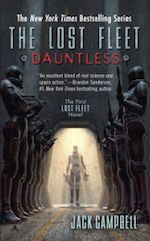 Sometimes, space opera exists as a framework for some truly epic space battles. Jack Campbell is the pen name of John G. Hemry, a retired U.S. Navy officer. In The Lost Fleet: Dauntless, an Alliance fleet is moving toward a final clash with the Syndicate Worlds, and discovers an escape pod containing a man floating in suspended animation for a century. It is Captain “Black Jack” Geary, a legend from an early battle in the war. Geary finds the fleet much more brutal, hardened by decades of warfare. When the fleet is trapped, the Admiral leaves to negotiate surrender, and puts Geary in charge (after all, he has one heck of a “date of rank” when compared with the other captains). When the Admiral is executed, Geary decides the fleet should fight their way out, and the series describes their epic battle to get home. Campbell does a great job setting up massive fleet actions, and presenting them in a clear manner, not an easy feat. The series functions as a meditation on military virtues, as Geary struggles to be true to principles society has abandoned. Those who enjoy the books will have plenty to read, as it has spun off into two related series.
Sometimes, space opera exists as a framework for some truly epic space battles. Jack Campbell is the pen name of John G. Hemry, a retired U.S. Navy officer. In The Lost Fleet: Dauntless, an Alliance fleet is moving toward a final clash with the Syndicate Worlds, and discovers an escape pod containing a man floating in suspended animation for a century. It is Captain “Black Jack” Geary, a legend from an early battle in the war. Geary finds the fleet much more brutal, hardened by decades of warfare. When the fleet is trapped, the Admiral leaves to negotiate surrender, and puts Geary in charge (after all, he has one heck of a “date of rank” when compared with the other captains). When the Admiral is executed, Geary decides the fleet should fight their way out, and the series describes their epic battle to get home. Campbell does a great job setting up massive fleet actions, and presenting them in a clear manner, not an easy feat. The series functions as a meditation on military virtues, as Geary struggles to be true to principles society has abandoned. Those who enjoy the books will have plenty to read, as it has spun off into two related series.
Final Thoughts
So there you have it—ten space opera universes I’ve enjoyed. Space operas offer some of the purest fun of any tales within the genre. They are full of big ideas, big marvels, and big adventures. And, like I said right from the start, the list is by no means complete, as my favorites could have included dozens more. I’ll now open the floor to you, and get your help rounding out the list. What are some of your favorite space operas? What elements drew you to those particular stories? What scientific shortcuts and clichés are you willing to overlook in pursuit of a good story? And what authors are best at writing big, impressive stories across a big canvas?
Alan Brown has been a science fiction fan for five decades, and likes nothing better than a good space opera that keeps him reading past his bedtime. He writes a monthly series for Tor.com reviewing classic science fiction books, many of which fall right into the space opera wheelhouse.










